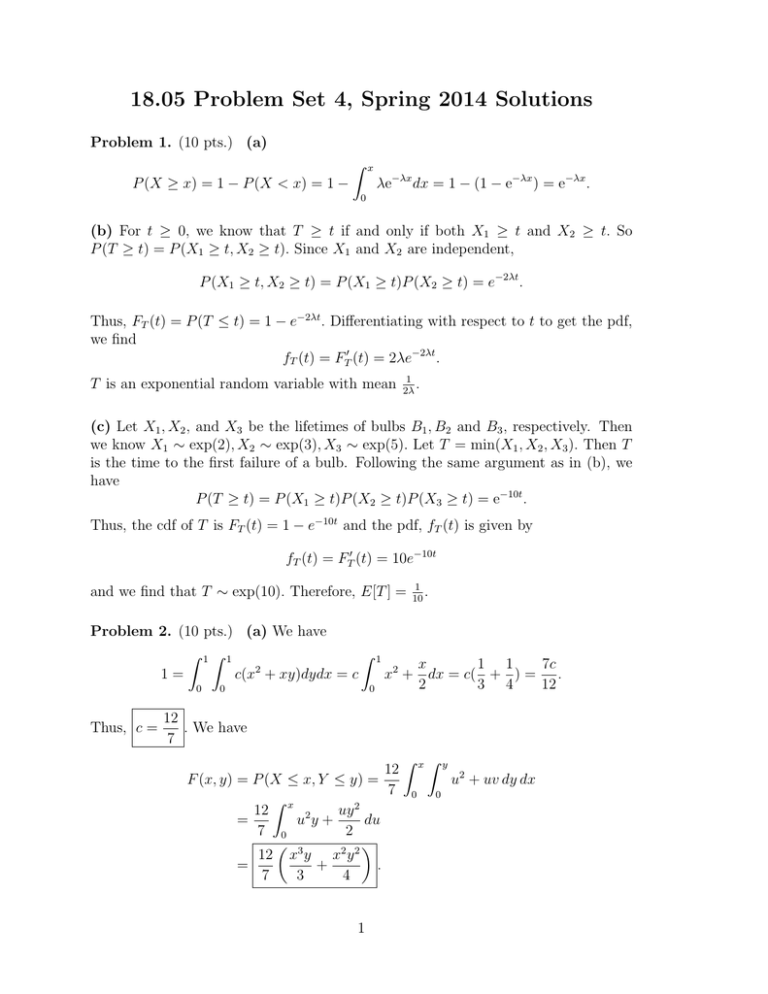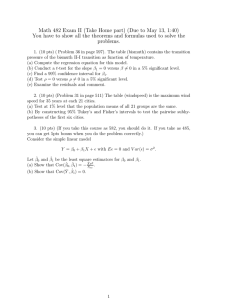Document 13436872
advertisement

18.05 Problem Set 4, Spring 2014 Solutions
Problem 1. (10 pts.) (a)
x
λe−λx dx = 1 − (1 − e−λx ) = e−λx .
P (X ≥ x) = 1 − P (X < x) = 1 −
0
(b) For t ≥ 0, we know that T ≥ t if and only if both X1 ≥ t and X2 ≥ t. So
P (T ≥ t) = P (X1 ≥ t, X2 ≥ t). Since X1 and X2 are independent,
P (X1 ≥ t, X2 ≥ t) = P (X1 ≥ t)P (X2 ≥ t) = e−2λt .
Thus, FT (t) = P (T ≤ t) = 1 − e−2λt . Differentiating with respect to t to get the pdf,
we find
fT (t) = FT� (t) = 2λe−2λt .
T is an exponential random variable with mean
1
.
2λ
(c) Let X1 , X2 , and X3 be the lifetimes of bulbs B1 , B2 and B3 , respectively. Then
we know X1 ∼ exp(2), X2 ∼ exp(3), X3 ∼ exp(5). Let T = min(X1 , X2 , X3 ). Then T
is the time to the first failure of a bulb. Following the same argument as in (b), we
have
P (T ≥ t) = P (X1 ≥ t)P (X2 ≥ t)P (X3 ≥ t) = e−10t .
Thus, the cdf of T is FT (t) = 1 − e−10t and the pdf, fT (t) is given by
fT (t) = FT� (t) = 10e−10t
and we find that T ∼ exp(10). Therefore, E[T ] =
1
.
10
Problem 2. (10 pts.) (a) We have
1
1
0
Thus, c =
1
c(x2 + xy)dydx = c
1=
0
0
x
1 1
7c
x2 + dx = c( + ) = .
2
3 4
12
12
. We have
7
F (x, y) = P (X ≤ x, Y ≤ y) =
12
=
7
=
12
7
x
0
uy 2
u2 y +
du
2
x3 y x2 y 2
+
3
4
1
.
12
7
x
y
u2 + uv dy dx
0
0
18.05 Problem Set 4, Spring 2014 Solutions
2
(b) The marginal pdf’s are:
Z
1
12 2 x
x +
7
2
0
Z 1
12 1 y
fY (y) =
f (x, y) dx =
+
.
7 3 2
0
fX (x) =
f (x, y) dy =
The marginal cdf’s are:
x3 x2
+
3
4
12 y y 2
FY (y) = F (1, y) =
+
.
7 3
4
12
FX (x) = F (x, 1) =
7
(c)
Z
12 1
x
12 1 1
5
2
x x +
dx =
=
≈ 0.7143
+
xfX (x) dx =
E(X) =
7 0
2
7 4 6
7
0
Z 1
39
2
E(X ) =
x2 fX (x) dx =
≈ 0.5571.
70
0
Z
1
Thus Var(X) = E(X 2 ) − E(X)2 ≈ 0.0469 .
(d)
Z
12 1
1 y
4
y
+
dy = ≈ 0.5714
E(Y ) =
yfY (y) dy =
7 0
3 2
7
0
Z 1
Z 1 12
1 y
17
y2
+
dy =
≈ 0.4048
E(Y 2 ) =
y 2 fY (y) =
7 0
3 2
42
0
Var(Y ) = E (Y 2 ) − E(Y )2 ≈ 0.0782
Z 1Z 1
Z Z
12 1 1
3
17
≈ 0.4048
E(XY ) =
xyf (x, y) dy dx =
x y + x2 y 2 dy dx =
7 0 0
42
0
0
Cov(X, Y ) = E(XY ) − E(X)E(Y ) ≈ −0.0034
Cov(X, Y )
Cor(X, Y ) =
= −0.0561
σX σY
Z
1
Problem 3. (10 pts.) (a) Define
�
1 if person i supports Erika
Xi =
0 if person i does not support Erika
18.05 Problem Set 4, Spring 2014 Solutions
3
Then Xi ∼ Bern(0.5) and the number of people who prefer Erika is
S = X1 + · · · + X400 .
We know E(Xi ) = 1/2 and Var(Xi ) = 1/4. This implies E(S) = 200 and Var(S) =
100. Thus the central limit theorem tells us that
S ≈ N(200, 100).
The problem asks for P (S > 210):
S − 200
210 − 200
P (S > 210) = P
>
≈ P (Z > 1) ≈ 0.16 .
10
10
(b) If we now let Yi = 1 if person i prefers one of Peter, Jon or Jerry and 0 otherwise,
we have Y1 , . . . , Y400 independent Bern(0.3). So E(Yi ) = µ = 0.3 and Var(Yi ) =
1
(0.3)(0.7) = 0.21. If Y 400 = 400
(Y1 + · · · + Y400 ), the Central Limit Theorem tells us
√
Yn−µ
(Y n − 0.3) 400
√
√
=
σ/ 400
0.21
is approximately standard normal. If Z is standard normal, then
√
(0.25 − 0.3) 400
√
P (Y ≤ 0.25) ≈ P Z <
≈ 0.0145.
0.21
Problem 4. (10 pts.)
Let S be the total rounding error for a day. The problems asks for
P (|S| > 100).
Let Xi be the rounding error (in cents) of the ith order. Then Xi takes values
−2, −1, 0, 1, 2, each with probability 15 . We compute
E(Xi ) = µ = 0,
Var(Xi ) = σ 2 = 2.
The total rounding error S = X1 + · · · + X1000 . By the Central Limit Theorem, we
know that S ≈ N(0, 2000).
|S − 0|
100
100
P (|S| ≥ 100) = P ( √
≥√
≈ P |Z| ≥ √
= 0.02534 .
2000
2000
2000
Extra credit 5 points Here’s my code.
r = c(0,-1,-2,2,1) # rounding error for 0, 1, 2, 3, 4 cents
ntrials = 10000
18.05 Problem Set 4, Spring 2014 Solutions
4
data = rep(0,1000)
for (j in 1:ntrials)
{
x = sample(r,1000,replace=TRUE) #rounding from 1000 orders
trial = sum(x) # total rounding error
data[j] = trial
}
mean(abs(data) > 100 ) # fraction of rounding errors > 100 or < -100
In three runs it gave 0.0269, 0.0265, 0.0276. This agrees nicely with the CLT esti­
mate.
Problem 5. (10 pts.) From the table we compute the marginal probabilities
1
P (X = 1) = ,
3
Since P (X = 1, Y = 1) =
independent.
1
18
1
P (Y = 1) = .
3
and P (X = 1)P (Y = 1) =
1
,
9
X and Y are not
Problem 6. (10 pts.) Solution: (a) The marginal distributions allow us to deter­
mine the joint distribution of X and Y in terms of c:
Y \X
1
-1
1
c
.5 − c .5
-1
.5 − c
c
.5
.5
.5
We easily compute: E(X) = 0, E(Y ) = 0, Var(X) = 1, Var(Y ) = 1. So, computing
directly
E(XY ) = (1 · 1)c + (−1 · 1)(.5 − c) + (1 · −1)(.5 − c) + (−1 · −1)c
= 4c − 1
Thus,
Cor(X, Y ) = E(XY ) − E(X)E(Y ) = 4c − 1
Cor(X, Y )
Cov(X, Y ) =
= 4c − 1.
σ X σY
(b) Note that the correlation runs from −1 to 1 as c runs from 0 to .5.
We must have Cov(X, Y ) = 0 for X and Y to be independent. This only happens
when c = 14 . It is easy to check in this case that all four probabilities in the table are
0.5 and they are independent.
When c = 0 the correlation is -1, which means X and Y are fully correlated (some­
times called fully anti-correlated). When c = 0.5 the correlation is 1.0 and X and Y
are fully correlated.
18.05 Problem Set 4, Spring 2014 Solutions
5
Problem 7. (10 pts.) (a) The joint probability density function is f (a, b) =
and the joint cumulative density function is
Z aZ b
ab
F (a, b) =
f (s, t) ds dt =
3600
0
0
1
3600
(b) Since A is uniformly distributed on [0, 60], P (A ≤ 30) = 12 .
(c) i) P (A ≤ 15, 30 ≤ B ≤ 45) = P (A ≤ 15)P (30 ≤ B ≤ 45) = 0.0625
ii) The range of (A, B) is the square [0, 60] × [0, 60]. The event ‘Alice arrives before
12:15 and Bob arrives between 12:30 and 12:45’ is represented by the solid blue
rectangle. Since the probability distribution is uniform the probability of the blue
rectangle is just the fraction of the entire square the it covers.
(0, 60)
(60, 60)
A
(15, 45)
(0, 0)
(0, 30)
(60, 0)
B
(d) The shaded area in the figure below corresponds to the event ‘A ≤ B + 5’. (Note:
if Alice arrives before Bob then she arrives less than 5 minutes after him.) That is,
it corresponds to all pairs of arrival times (a, b) such that a ≤ b + 5. P (A ≤ B + 5)
is then just the area of the green region divided by the area of the entire square. We
552
find that the area of the white region is
. So
2
1
552
P (A ≤ B + 5) =
3600 −
= 0.5799 .
3600
2
(55, 60)
(60, 60)
=
A
A
B
+
5
(0, 60)
(0, 5)
(0, 0)
(60, 0)
B
18.05 Problem Set 4, Spring 2014 Solutions
6
(e) Alice and Bob arrive within 15 minutes of each other is event
E = ‘B − 15 ≤ A ≤ B + 150� .
This is the blue shaded region in the figure below. We see that the area of each white
452
triangle is
. So, the combined white area is 452 and
2
3600 − 452
7
=
.
3600
16
P (E) =
(0, 60)
(45, 60)
(60, 60)
15
A > B + 15
A
+
15
A
A
=
B
+
(60, 45)
B
=
(0, 15)
B > A + 15
(60, 0)
(0, 0) (15, 0)
B
MIT OpenCourseWare
http://ocw.mit.edu
18.05 Introduction to Probability and Statistics
Spring 2014
For information about citing these materials or our Terms of Use, visit: http://ocw.mit.edu/terms.




